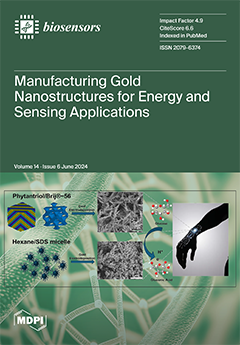Implantable and wearable bioelectronic systems can enable tailored therapies for the effective management of long-term diseases, thus minimising the risk of associated complications. In this context, glucose fuel cells hold great promise as in- or on-body energy harvesters for ultra-low-power bioelectronics and as
[...] Read more.
Implantable and wearable bioelectronic systems can enable tailored therapies for the effective management of long-term diseases, thus minimising the risk of associated complications. In this context, glucose fuel cells hold great promise as in- or on-body energy harvesters for ultra-low-power bioelectronics and as self-powered glucose sensors. We report here the generation of gold nanostructures through a gold electrodeposition method in a soft template for the abiotic electrocatalysis of glucose in glucose fuel cells. Two different types of soft template were used: a lipid cubic phase-based soft template composed of Phytantriol and Brij
®-56, and an emulsion-based soft template composed of hexane and sodium dodecyl sulphate (SDS). The resulting gold structures were first characterised by SAXS, SEM and TEM to elucidate their structure, and then their electrocatalytic activity towards glucose was compared in both a three-electrode set-up and in a fuel cell set-up. The Phytantriol/Brij
®-56 template led to a nanofeather-like Au structure, while the hexane/SDS template led to a nanocoral-like Au structure. These templated electrodes exhibited similar electrochemical active surface areas (0.446 cm
2 with a roughness factor (RF) of 14.2 for Phytantriol/Brij
®-56 templated nanostructures and 0.421 cm
2 with an RF of 13.4 for hexane/SDS templated nanostructures), and a sensitivity towards glucose of over 7 μA mM
−1 cm
−2. When tested as the anode of an abiotic glucose fuel cell (in a phosphate-buffered solution with a glucose concentration of 6 mM), a maximum power density of 7 μW cm
−2 was reached; however the current density in the case of the fuel cell with the Phytantriol/Brij
®-56 templated anode was approximately two times higher, reaching the value of 70 μA cm
−2. Overall, this study demonstrates two simple, cost-effective and efficient strategies to manipulate the morphology of gold nanostructures, and thus their catalytic property, paving the way for the successful manufacturing of functional abiotic glucose fuel cells.
Full article






